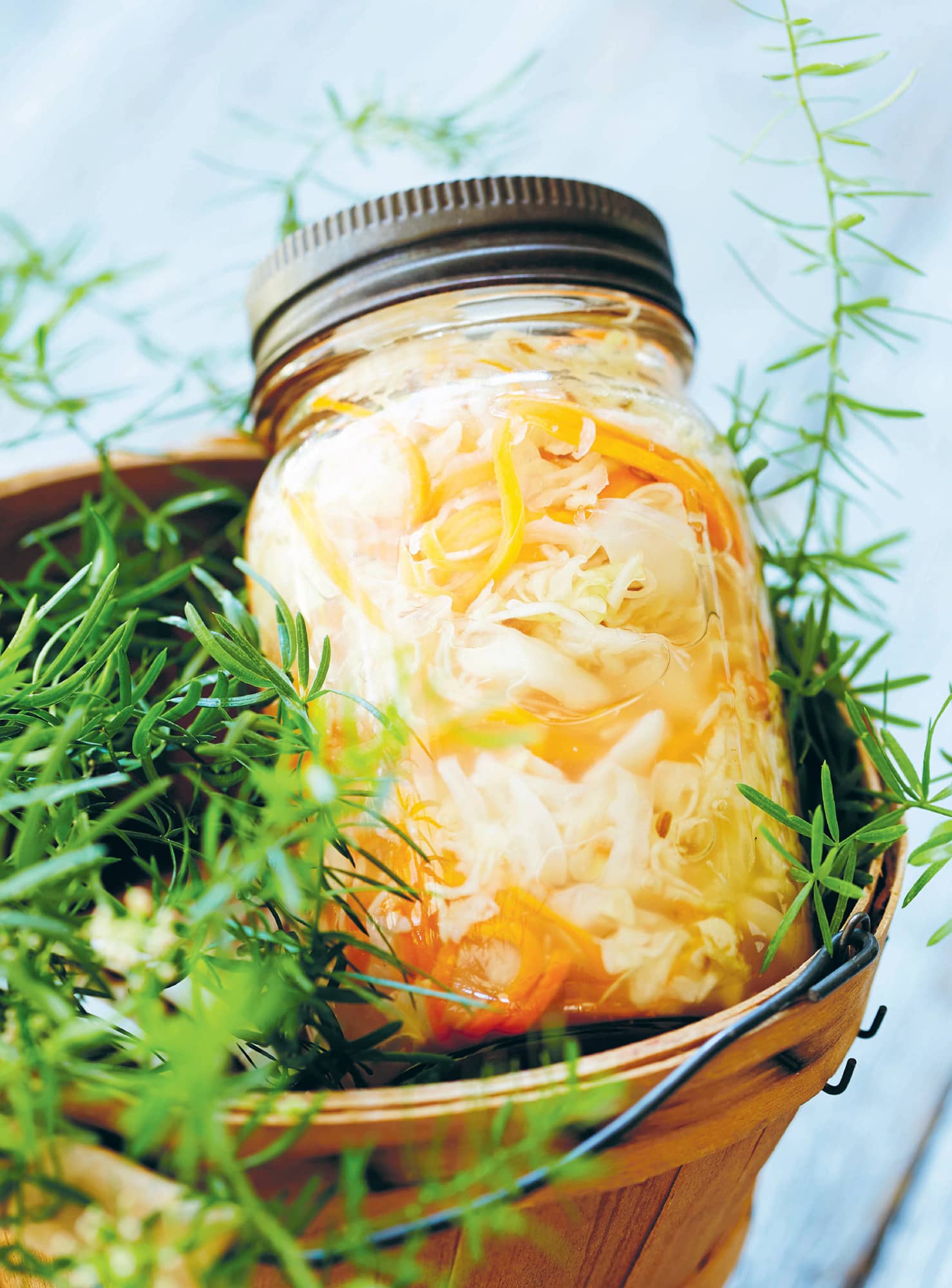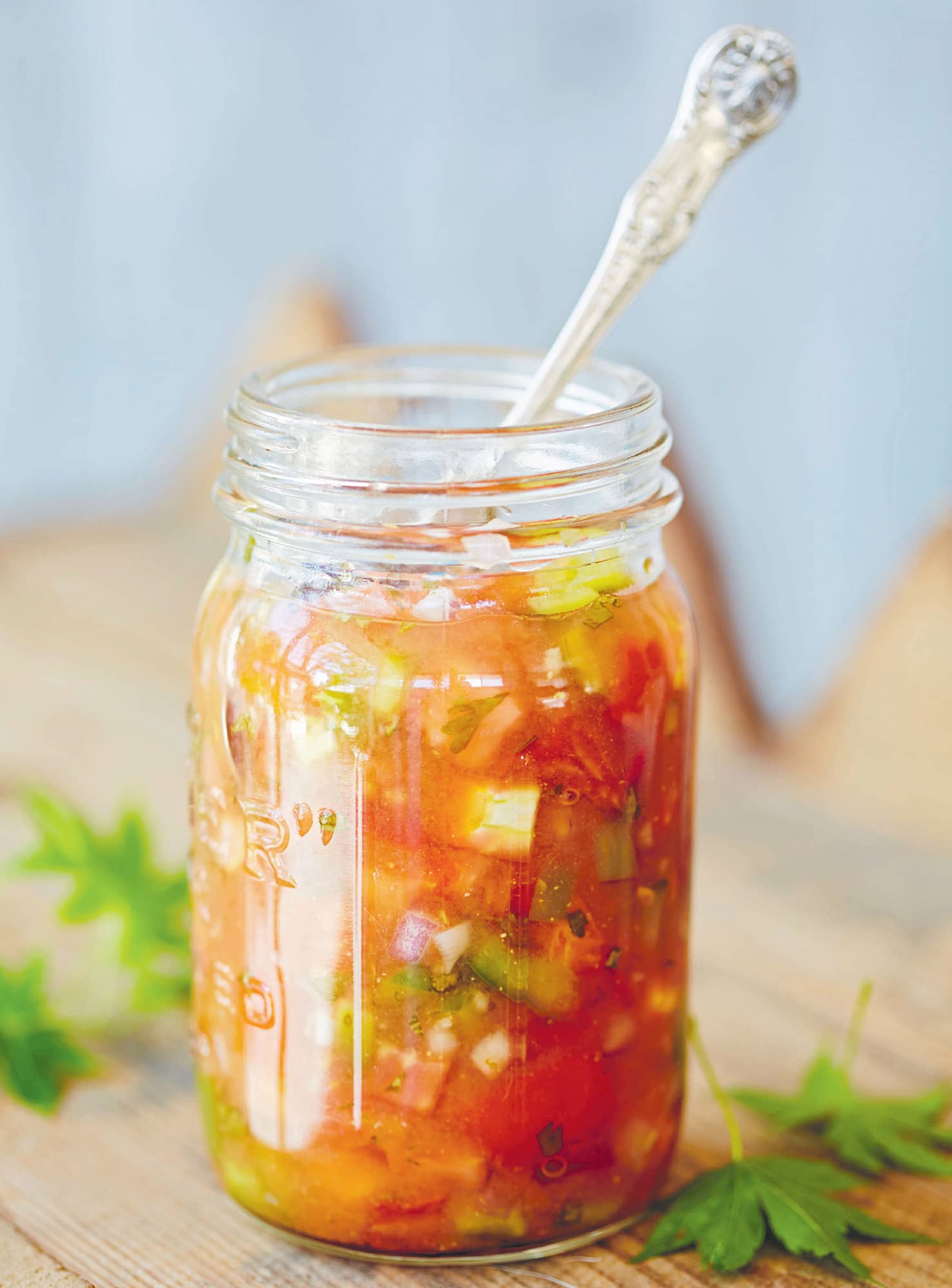
Fermented foods
(for when your gut is strong)
At phase three, when your gut is feeling stronger, you can start adding fermented foods to your diet to boost beneficial gut flora. Go gently and see how your gut reacts – try 1 teaspoon a day with lunch or dinner and build up when you feel ready.


◁ CULTURED VEGETABLES
 GF
GF  WF
WF  DF
DF  SF
SF  VEG
VEG
MAKES ABOUT 2 CUPS (l7 FL OZ/500 ML)
Fermentation has been practiced by many societies since long before industrialization and processed foods. Adding a culture or salt to foods enables the growth of Lactobacillus bacterial cultures (probiotics), which preserve the food through the production of lactic acid. Fermented foods are full of healthy enzymes, minerals and live cultures that create a flourishing internal environment and help boost beneficial gut flora, all contributing to good digestion, a strong immune system and protection from toxic pollutants. They also help our bodies draw nutrients from our food.
Fermented veggies are great to eat alongside a meal to help your tummy digest your foods, especially as an accompaniment to starches and proteins.
You’ll need one sterilized wide-mouthed, 4 cup (35 fl oz/1 L) capacity glass jar with lid (Mason jar).
1 small green cabbage, shredded
1 medium carrot, shredded (optional)
1 clove garlic, crushed
6 cups (52 fl oz/1.5 L) filtered water
1 tablespoon (18 g) finely ground Celtic sea salt
pinch of freshly cracked black pepper
1 tablespoon (7 g) caraway seeds
Mix the cabbage, carrot, if using, and garlic in a large bowl. Transfer this mixture to the sterilized jar, leaving a 1 inch (2.5 cm) space at the top. Using a wooden spoon, push the mixture down to remove any air pockets.
Pour the water into a jug and add the salt, pepper and caraway seeds. Stir until the salt dissolves. Pour the liquid into the jar, leaving 1 1/4 inches (3 cm) at the top to allow room for expansion during fermentation. Push the vegetables down again with the wooden spoon, ensuring they’re covered in the liquid. Put the lid on the jar, seal tightly and write the date on the jar.
Leave in a cool, dark, dry place for 3–5 days or until bubbles have started to form. Transfer to the fridge and enjoy for up to 4 weeks.
NOTE: Start with a teaspoonful and only include with meals once you’ve reached phase three, the maintenance and restoration phase.
KIMCHI
 GF
GF  WF
WF  DF
DF  SF
SF  VEG
VEG
MAKES ABOUT 4 CUPS (35 FL OZ/1 L)
Fermented foods are nature’s newest oldest superfoods, and their tangy flavors and spicy kick make them a perfect accompaniment to a meal once your gut is healed. Kimchi, a traditional Korean fermented food, offers a diverse range of wild bacterial strains that will benefit your inner ecology.
You’ll need two sterilized wide-mouthed, 4 cup (35 fl oz/1 L) capacity glass jars with lids (Mason jars).
1 small green cabbage, roughly chopped
1 daikon, peeled and grated
2 carrots, peeled and grated 1 zucchini, grated
1/4 cup (1 oz/30 g) chopped scallions
1 inch (2.5 cm) piece ginger, peeled and grated
2 cloves garlic, crushed
1 heaping tablespoon (3 g) chili flakes
1/4 cup (1 1/4 oz/35 g) finely ground Celtic sea salt
Combine the cabbage, daikon, carrot and zucchini in a glass mixing bowl. Add the scallion, ginger, garlic, chili and salt, then massage the vegetables, using your hands, for about 4 minutes or until softened. Set aside for an hour or so to allow the salt to draw the moisture out of the vegetables.
Spoon the vegetables and liquid into the sterilized jars, pressing down to pack firmly and leaving 1 inch (2.5 cm) at the top to allow for expansion during fermentation. Put the lids on, seal tightly and write the date on the jars.
Store in a cool, dark, dry place for 3 days or until bubbles start to form. Transfer to the fridge and enjoy for up to 8 weeks.
SUPERCHARGED TIP
Always use a clean spoon each time you remove a little of any preserve from its jar.
EASY-TO-MAKE SAUERKRAUT
 GF
GF  WF
WF  DF
DF  SF
SF  VEG
VEG
MAKES ABOUT 4 CUPS (35 FL OZ/1 L)
Homemade sauerkraut is full of the nutrients and phytochemicals that make cabbage a superstar ingredient, and the fermentation process makes them easier for the body to absorb. It also contains probiotics to recolonize your digestive tract, and is best enjoyed 1 tablespoon at a time, as a side with your meal.
You’ll need two sterilized wide-mouthed, 4 cup (35 fl oz/1 L) capacity glass jars with lids (Mason jars).
1/2 green cabbage, finely sliced
8 cups (68 fl oz/2 L) filtered water
1 tablespoon (18 g) finely ground Celtic sea salt
2 cloves garlic, crushed
1 tablespoon (7 g) caraway seeds
Put the cabbage in the sterilized jars and press down with a wooden spoon to ensure it’s tightly packed. Each jar should be three-quarters full.
Combine the water, salt, garlic and caraway seeds in a jug, stirring to dissolve the salt, then pour this mixture over the cabbage, leaving 1 inch (2.5 cm) at the top to allow for expansion during fermentation. Ensure the liquid is covering the cabbage, then put the lids on the jars and seal tightly. Write the date on the jars.
Store in a cool, dark, dry place for 3 days or until bubbles start to form. Transfer to the fridge and enjoy for up to 4 weeks.
SUPERCHARGED TIP
For fermented foods, always use filtered water, as chlorinated tap water can inhibit fermentation. Choose iodine-free salt with no anti-caking agents, which can also inhibit fermentation. Never omit the salt – it’s a vital part of the preservation process.

◁ FERMENTED SALSA
 GF
GF  WF
WF  DF
DF  SF
SF  VEG
VEG
MAKES ABOUT 2 CUPS (l7 FL OZ/500 ML)
This zingy and tangy salsa will pep you up and restore beneficial flora to your gut. Use as a dip with your favorite gluten-free cracker, add to steamed vegetables, serve alongside a salad, or plop on top of Scrambled Eggs or Fennel, Tomato and Roast Garlic Soup.
You can buy vegetable starter at your local health food store or online. You’ll need one sterilized wide-mouthed, 2 cups (17 fl oz/500 ml) capacity glass jar with a lid (Mason jar).
1 medium red (Spanish) onion, diced
3 tomatoes, diced
1 medium green pepper, seeded and diced
1 small red or green chili, finely chopped
2 cloves garlic, crushed
1 handful of fresh cilantro, finely chopped
1/4 teaspoon ground cumin
1 tablespoon (20 ml) lime juice
grated zest of 1 lime
2 teaspoons Celtic sea salt (or 1/4 cup/2 fl oz/60 ml vegetable starter culture and 1 teaspoon Celtic sea salt)
Thoroughly combine all the ingredients in a glass mixing bowl. Spoon into the sterilized jar, pressing down with a wooden spoon to pack firmly, leaving 1 inch (2.5 cm) at the top for expansion during fermentation. Put the lid on, seal tightly and write the date on the jar.
Store in a cool, dark, dry place for 3 days or until bubbles start to form. Transfer to the fridge and enjoy for up to 6 weeks.

◁ HOMEMADE KOMBUCHA
 GF
GF  WF
WF  DF
DF  VEG
VEG
MAKES 4 CUPS (35 FL OZ/1 L)
Kombucha begins life as an ordinary sugary tea, but the addition of a SCOBY (symbiotic culture of bacteria and yeast) transforms it into a fermented drink. The SCOBY bacteria and yeast eat most of the sugar, yielding a drink full of natural probiotics that will dance around happily in your intestines. A small amount drunk daily has many gut-healing properties. Once you get the hang of making it, you can flavor it up with ginger and turmeric or even berries.
Purchase a SCOBY online or, if you’re very lucky, a friend might give you one. You can buy kombucha online or at a health food store, although once you’ve made your first batch, you won’t need to buy it any more. You’ll also need a breathable cloth such as cheesecloth (I use a nut bag), a rubber band, and one sterilized wide-mouthed, 4 cup (35 fl oz/1 L) capacity glass jar with a lid (Mason jar).
4 cups (35 fl oz/1 L) filtered water
2 organic black tea bags
1/4 cup (2 oz/55 g) organic sugar
1 SCOBY (see above)
3 1/2 fl oz (100 ml) homemade or store-bought kombucha (see above)
Put the water in a medium saucepan over medium heat and bring to a boil. Remove from the heat, add the tea bags, and steep for 20 minutes. Remove the tea bags, add the sugar and stir until dissolved. Set aside to cool.
Pour the tea into the sterilized jar, then add the SCOBY and the kombucha. Cover with cheesecloth, secure with a rubber band and write the date on the jar.
Store undisturbed in a cool, dark, dry place for 7 days, then test it to see if it’s ready. It should be fizzy and slightly sour/vinegary. If it’s still sweet, let it ferment for a day or so longer (up to 10 days).
Once the kombucha is ready, carefully remove the SCOBY using a clean long-handled spoon and place it on a plate with a little of the liquid to stop it drying out (then use it to make another batch straight away). Pour out 3 1/2 fl oz (100 ml) of the kombucha and keep aside to make another batch, then pour the remaining liquid into a jug through a sieve and then into a clean glass bottle with a lid. Secure the lid tightly and write the date on the bottle. The kombucha will keep in the fridge for 2–4 weeks.
